- Introduction to tooth sensitivity
- Dentine hypersensitivity
- Pulp disease
- Diagnosis of tooth sensitivity
- Treatment of pulpal disease
- Treatment of dentine hypersensitivity
Introduction to tooth sensitivity
Tooth sensitivity can be classified into two categories: one may indicate a problem with the tooth‘s nerve and blood supply (the root canal); and the other may be caused by the exposure of dentine, resulting in dentine hypersensitivity. Dentine is a sponge-like material containing small channels that connect the root canal space (pulp) to the outside of the dentine (cementum). Thus, when dentine is exposed, there can be sensitivity.
Dentine hypersensitivity
Dentine hypersensitivity is a short, sharp pain caused by exposure of the dentine, which cannot be explained by any form of disease such as dental decay. Dentine hypersensitivity is a condition that can affect up to one in every second person at some time in their lives. This condition is estimated to affect about 40 million adults in the United States.
Dentine hypersensitivity most commonly affects people in their twenties and thirties, despite the fact that older groups tend to show more exposed dentine. This may be for several reasons, including the main fact that the tubes that make up the spongy dentine fill with mineral deposits which partially close the tubes, therefore reducing sensitivity. Age changes to the dentine also make it less likely to cause sensitivity.
What does dentine hypersensitivity feel like?
Dentine hypersensitivity can be best described as a short, sharp pain arising from exposed dentine due to a loss of the surface of the tooth (enamel or cementum). When the problem that causes dentine hypersensitivity is removed, there should not be any more pain.
The most common complaint is sensitivity to cold; however the pain may also be caused by:
- Acidic foods and drinks (e.g. fruit and wine);
- Dentists blowing air on the tooth;
- Brushing too hard in the sensitive area, or rubbing the area with a fingernail or toothpick; and/or
- Breathing through the mouth, particularly in winter.
What is actually causing pain?
Dentine is actually made up of a lot of tiny tubes that go from the inside of the tooth, to the outside of the dentine. These small tubes contain something called dentinal fluid. Various stimuli displace the dentinal fluid inwardly or outwardly. The movement of the dentinal fluid activates the nerve endings at the pulp/dentin interface, which causes the pain felt by the person. Anything that increases dentinal fluid movement or dentinal permeability increases sensitivity
What causes dentine hypersensitivity?
Too little or too much brushing
Very strong brushing of teeth, especially in people who have slightly crowded teeth, or even a lack of brushing that results in lots of plaque and calculus developing, will cause the gums to shrink around the tooth. Shrinkage of the gums will expose cementum and root dentine, which may cause sensitivity.
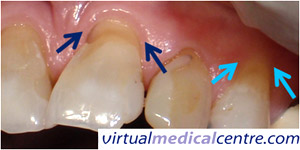 Figure 1: Toothbrush abrasions caused by strong brushing (marked by arrows). |
Low level of dental hygiene
Poor dental hygiene will lead to gum disease, and will lead to gum shrinkage. Bacteria (in plaque and calculus) also release acids around the tooth, which may also lead to sensitivity.
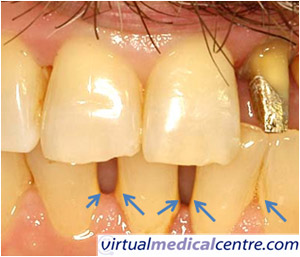 Figure 2: Deposits of calculus which have developed due to improper flossing. This is a very common site for calculus to form. |
Treatment of gum disease
Treatment of gum disease requires the dentist to literally scrape the calculus and small portions of the tooth. This could cause hypersensitivity due to the dentine being exposed.
Gums may also recede due to gum disease treatment, which may increase the chance of having sensitivity.
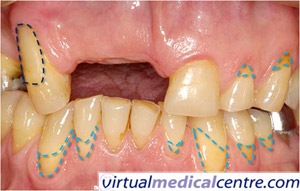 Figure 3: The area of recession that has developed due to a combination of age-related changes, and history of gum disease (light blue). The dark blue area has a white filling which may have been placed there to treat dentine hypersensitivity. |
Dental erosion
Dental erosion can be caused by diet, medications, drugs, reflux or regurgitation of stomach acids. This leads to a loss of some of the tooth structure, which may expose dentine. This process can lead to severe dental wear if combined with clenching or grinding, or even brushing immediately after exposure to acids.
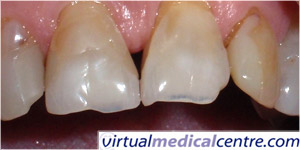 Figure 4a: Dental erosion on the front teeth. Note that there is some translucency at the end of the front tooth. |
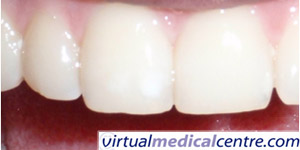 Figure 4b: Healthy front teeth which show very small signs of dental erosion. |
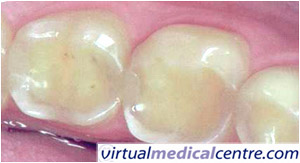 Figure 5a: Dental erosion on the back teeth. Note that the the back teeth are very glassy, and do not have ridges on the tooth. |
 Figure 5b: Healthy back teeth which have nice ridges and fissures evident. |
Age changes in the gums
As individuals age, there is a tendency for the gums to shrink and expose dentine.
Tooth whitening
While sensitivity can occur due to a variety of factors, a majority of patients who undergo whitening treatments will experience bleaching-related sensitivity.
Cementation
Cementation of crowns and bridges may cause sensitivity due to the chemicals in the cement. This presents a problem when an expensive treatment is completed (e.g. sensitivity occurring after a crown is cemented).
Pulp disease
The pulp is the area in the middle of the tooth that contains blood vessels and nerves. Diseases of this area are difficult to diagnose as we cannot see directly into the root canal space (e.g. to see whether a blood supply still exists). Hence, the signs and symptoms will vary depending on the stage of the disease at the time. Diagnosis of the disease is based essentially on symptoms, and a few special tests the dentist performs.
Many of the signs and symptoms overlap between the various pulp conditions. Most people will experience sensitivity in the early stages of pulp disease, when the root canal’s blood system is still present. When the blood supply is gone due to infection, then there will be no sensitivity, but more a dull ache.
How the pulp responds to insults
Insults or injuries to the dental pulp can occur in many ways. Usually there is something that builds up over time to destroy the pulp’s blood and nerve supply. The most common cause is bacteria in dental decay due to:
- Fillings with decay underneath them;
- Teeth with cracks in them;
- Fillings that have broken; or
- Gum disease (very rarely).
If an injury of short duration occurs to the tooth, some cells may die in the tooth, and there will be inflammation in the tooth. This inflammation will cause the tooth to become sensitive to hot and cold things.
If these injuries of short duration happen often, then the tooth may not be able to recover following inflammation, the pulp will die, and the tooth may eventually become infected.
If a long-standing injury is left without treatment (e.g. bacteria as a result of a faulty filling), inflammation will become long standing, and the tooth’s pulp will eventually die. During chronic inflammation, the tooth will be very sensitive to heat and cold, and at times be quite sore to bite on as well.
It should be noted that once the pulp has died, there is no sensitivity in the tooth. This gives a false sense of security to the person, as they think that all is now well. However, during the period where there is no pain, the pulp is most likely becoming more infected, and eventually the bacteria attempts to leave the tooth via the bottom of the root, where a small gap exists. There will not be sensitivity at this stage, but there will be a dull pain when biting on the tooth in question.

Pain is usually characterised by the following features:
- The tooth is only sensitive when a stimulus (usually cold or sweet foods but sometimes heat) is applied to the tooth;
- The pain ceases within a few seconds or immediately upon removal of the stimulus;
- The pain is short and sharp in nature but does not occur by itself;
- Usually more extreme temperatures are required to cause the pain rather than mild changes (e.g. ice cream rather than tap water); and
- If there is pain to biting pressure as well as the above symptoms, then this may indicate a crack in the tooth or filling.
Once the dentist diagnoses the tooth with reversible pulpitis, the tooth is reviewed over a series of appointments to see if the symptoms get worse or if they resolve.
A pulp with irreversible pulpitis has inflammation and it is not capable of healing at all. If a tooth has irreversible pulpitis, then the tooth’s pulp will eventually die, and then become infected.
The classic symptoms of irreversible pulpitis are:
- The pain is a lingering pain caused by heat or cold;
- Only mild temperature changes are required to cause the pain (e.g. tap water, breathing cold air);
- The initial reaction is a very sharp pain to hot or cold stimuli, which then lingers for minutes to hours after the stimulus is removed;
- The lingering pain is usually a dull ache or a throbbing pain; and
- The pain is spontaneous, which may wake the patient at night and may become worse when lying down.
Patients with irreversible pulpitis often need strong pain killers.
Diagnosis of tooth sensitivity
The characteristics of dentine hypersensitivity and pulpal disease that lead to tooth sensitivity are discussed above.
The specific tests used to diagnose tooth sensitivity are essentially the same as that of dental pain.
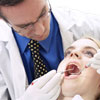 |
For more information, see Dental Pain: How is it Diagnosed? |
Treatment of pulpal disease
The treatment of pulpal disease is covered in dental pain.
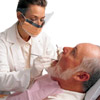 |
For more information, see Dental Pain: How is it Treated? |
Treatment of dentine hypersensitivity
Nowadays, two main methods are used in the treatment of dentine hypersensitivity:
- The most common method is by blocking the small tubes that make up dentine; and
- Blocking nerve pathways that usually send pain signals to the brain.
As mentioned before, dentine is like a sponge and contains tubes that extend from the pulp to the outside of the dentine. If these tubes are exposed for any reason, then there can be pain. When these tubes are exposed and the person is experiencing pain, we can try blocking these tubes by using many different techniques.
Fluoride, when applied to the site causing pain, has been used effectively in the treatment of dentine hypersensitivity. Fluorides seem to create a barrier on the surface of the dentine, minimising the feeling of discomfort.
Long used to treat dentine hypersensitivity, toothpastes are cheap and able to be applied at home. Many toothpastes contain abrasive components to block the small tubes in dentine.
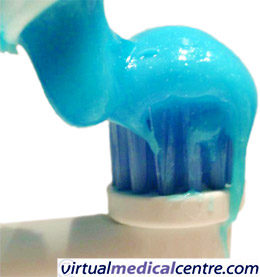 Figure 6: A sensitive toothpaste being placed onto a toothbrush. Remember to use no water when brushing! |
Information on re-publishing of our images
It is important that toothpastes are not placed on by a finger, but are rather brushed onto the surface. You should not use any water with the toothpaste, nor rinse immediately, as it may dilute the effect.
 |
For more information, see Dental Hygiene (Proper Brushing and Flossing Techniques). |
Less common forms of blocking dentine
There are many other ways of blocking the dentine tubes, which include:
- Fluoride iontophoresis;
- Ammonium hexafluorosilicate;
- Potassium oxalate;
- Copal varnish;
- Calcium hydroxide;
- Strontium chloride and zinc chloride;
- Dental resins and adhesives;
- Fillings;
- Lasers.
Blockade of nerve pathway to brain
Unlike other forms of treatment, potassium nitrate does not reduce the symptoms associated with dentine hypersensitivity by blocking the dentine tubes. It appears to act on the nerve, blocking its pain signal to the brain.
Kindly written by Dr Akhil Chandra BDSc. (Hons UWA)
Dentist, Whitfords Dental Centre and Editorial Advisory Board Member of the Virtual Dental Centre
References
- Bal J, Kundalgurki S. Tooth sensitivity prevention and treatment. Oral Health. 1999;89(2):33-4, 37-8, 41.
- Dowell P, Addy M. Dentine hypersensitivity – a review. Aetiology, symptoms and theories of pain production. J Clin Periodontol. 1983;10(4):341-50.
- Consensus-based recommendations for the diagnosis and management of dentin hypersensitivity. J Can Dent Assoc. 2003;69(4):221-6.
- Porto IC, Andrade AK, Montes MA. Diagnosis and treatment of dentinal hypersensitivity. J Oral Sci. 2009;51(3):323-32.
- Flynn J, Galloway R, Orchardson R. The incidence of ‘hypersensitive’ teeth in the West of Scotland. J Dent. 1985;13(3):230-6.
- Chidchuangchai W, Vongsavan N, Matthews B. Sensory transduction mechanisms responsible for pain caused by cold stimulation of dentine in man. Arch Oral Biol. 2007;52(2):154-60.
- Brännström M, Åström A. A study on the mechanism of pain elicited from the dentin. J Dent Res. 1964;43(4):619-25.
- Roberson TM, Heymann HO, Swift EJ Jr (eds). Sturdevant’s Art and Science of Operative Dentistry (4th edition). St Louis: Mosby; 2002.
- Orchardson R, Cadden SW. An update on the physiology of the dentine-pulp complex. Dent Update. 2001;28(4):200-6, 8-9.
- Yoshiyama M, Noiri Y, Ozaki K, Uchida A, Ishikawa Y, Ishida H. Transmission electron microscopic characterization of hypersensitive human radicular dentin. J Dent Res. 1990;69(6):1293-7.
- Suge T, Kawasaki A, Ishikawa K, Matsuo T, Ebisu S. Effects of plaque control on the patency of dentinal tubules: An in vivo study in beagle dogs. J Periodontol. 2006;77(3):454-9.
- Kawasaki A, Ishikawa K, Suge T, Shimizu H, Suzuki K, Matsuo T, et al. Effects of plaque control on the patency and occlusion of dentine tubules in situ. J Oral Rehabil. 2001;28(5):439-49.
- Pashley DH. Mechanisms of dentin sensitivity. Dent Clin North Am. 1990;34(3):449-73.
- Eisenburger M, Addy M. Erosion and attrition of human enamel in vitro part I: Interaction effects. J Dent. 2002;30(7-8):341-7.
- Osborne-Smith KL, Burke FJ, Wilson NH. The aetiology of the non-carious cervical lesion. Int Dent J. 1999;49(3):139-43.
- Marvin K. Bright, white, and sensitive: An overview of tooth whitening and dentin hypersensitivity. Dent Today. 2008;27(5):80-1.
- Abbott PV, Yu C. A clinical classification of the status of the pulp and the root canal system. Aust Dent J. 2007;52(1 Suppl):S17-31.
- Olgilvie AL. Pulpal pathosis. In: Ingle J (ed). Endodontics. London: Kimpton; 1965: 295-345.
- Abbott PV. Endodontics and Dental Traumatology: An Overview of Modern Endodontics. Perth: International Federation of Endodontic Associations; 1999.
- Abbott PV. The periapical space – a dynamic interface. Aust Endod J. 2002;28(3):96-107.
- Ling TY, Gillam DG. The effectiveness of desensitizing agents for the treatment of cervical dentine sensitivity (CDS) – a review. J West Soc Periodontol Periodontal Abstr. 1996;44(1):5-12.
- Paine ML, Slots J, Rich SK. Fluoride use in periodontal therapy: A review of the literature. J Am Dent Assoc. 1998;129(1):69-77.
- Leonard RH Jr, Smith LR, Garland GE, Caplan DJ. Desensitizing agent efficacy during whitening in an at-risk population. J Esthet Restor Dent. 2004;16(1):49-56.
- Singal P, Gupta R, Pandit N. 2% sodium fluoride-iontophoresis compared to a commercially available desensitizing agent. J Periodontol. 2005;76(3):351-7.
- Suge T, Kawasaki A, Ishikawa K, Matsuo T, Ebisu S. Ammonium hexafluorosilicate elicits calcium phosphate precipitation and shows continuous dentin tubule occlusion. Dent Mater. 2008;24(2):192-8.
- Suge T, Kawasaki A, Ishikawa K, Matsuo T, Ebisu S. Effect of ammonium hexafluorosilicate on dentin tubule occlusion for the treatment of dentin hypersensitivity. Am J Dent. 2006;19(4):248-52.
- Pillon FL, Romani IG, Schmidt ER. Effect of a 3% potassium oxalate topical application on dentinal hypersensitivity after subgingival scaling and root planing. J Periodontol. 2004;75(11):1461-4.
- Prati C, Venturi L, Valdrè G, Mongiorgi R. Dentin morphology and permeability after brushing with different toothpastes in the presence and absence of smear layer. J Periodontol. 2002;73(2):183-90.
- Minkoff S, Axelrod S. Efficacy of strontium chloride in dental hypersensitivity. J Periodontol. 1987;58(7):470-4.
- Powell LV, Gordon GE, Johnson GH. Sensitivity restored of Class V abrasion/erosion lesions. J Am Dent Assoc. 1990;121(6):694-6.
- Kimura Y, Wilder-Smith P, Yonaga K, Matsumoto K. Treatment of dentine hypersensitivity by lasers: A review. J Clin Periodontol. 2000;27(10):715-21.
All content and media on the HealthEngine Blog is created and published online for informational purposes only. It is not intended to be a substitute for professional medical advice and should not be relied on as health or personal advice. Always seek the guidance of your doctor or other qualified health professional with any questions you may have regarding your health or a medical condition. Never disregard the advice of a medical professional, or delay in seeking it because of something you have read on this Website. If you think you may have a medical emergency, call your doctor, go to the nearest hospital emergency department, or call the emergency services immediately.







